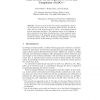NFM
2011
14 years 1 months ago
2011
A main idea underlying bounded model checking is to limit the length of the potential counter-examples, and then prove properties for the bounded version of the problem. In softwar...
ENTCS
2006
14 years 6 months ago
2006
Partially Ordered Symbolic Automata (POSAs) are used as the semantical foundation of visual formalisms like the scenario based language of Live Sequence Charts (LSCs). To check whe...
BIRTHDAY
2010
Springer
14 years 8 months ago
2010
Springer
Abstract. We investigate the power of play-out, the execution mechanism associated with scenario-based programming, which was defined as the operational semantics of live sequence ...
DAGSTUHL
2003
14 years 8 months ago
2003
The play-in/play-out approach is a method for specifying and developing complex reactive systems. It is built upon a scenariobased philosophy, and uses the language of live sequenc...
ICSE
2010
IEEE-ACM
14 years 8 months ago
2010
IEEE-ACM
We present LM, a tool for mining scenario-based specifications in the form of Live Sequence Charts, a visual language that extends sequence diagrams with modalities. LM comes with...
BIRTHDAY
2008
Springer
14 years 8 months ago
2008
Springer
Abstract. We survey some of the main results regarding the complexity and expressive power of Live Sequence Charts (LSCs). We first describe the two main semantics given to LSCs: a...
ISSS
2002
IEEE
14 years 11 months ago
2002
IEEE
This paper proposes a simulation-based methodology for validation of a system under design in an early phase of development. The key element of this approach is the visual speci�...
PADL
2004
Springer
15 years 4 days ago
2004
Springer
Message Sequence Charts (MSC) have traditionally been used as a weak form of behavioral requirements in software design; they denote scenarios which may happen. Live Sequence Chart...
BIRTHDAY
2005
Springer
15 years 10 days ago
2005
Springer
Constructing a program from a specification is a long-known general and fundamental problem. Besides its theoretical interest, this question also has practical implications, since...
FASE
2007
Springer
15 years 29 days ago
2007
Springer
We report on S2A, a compiler that translates Modal UML Sequence Diagrams (MSDs), a UML-compliant version of Live Sequence Charts (LSCs), into AspectJ code. It thus provides full co...






